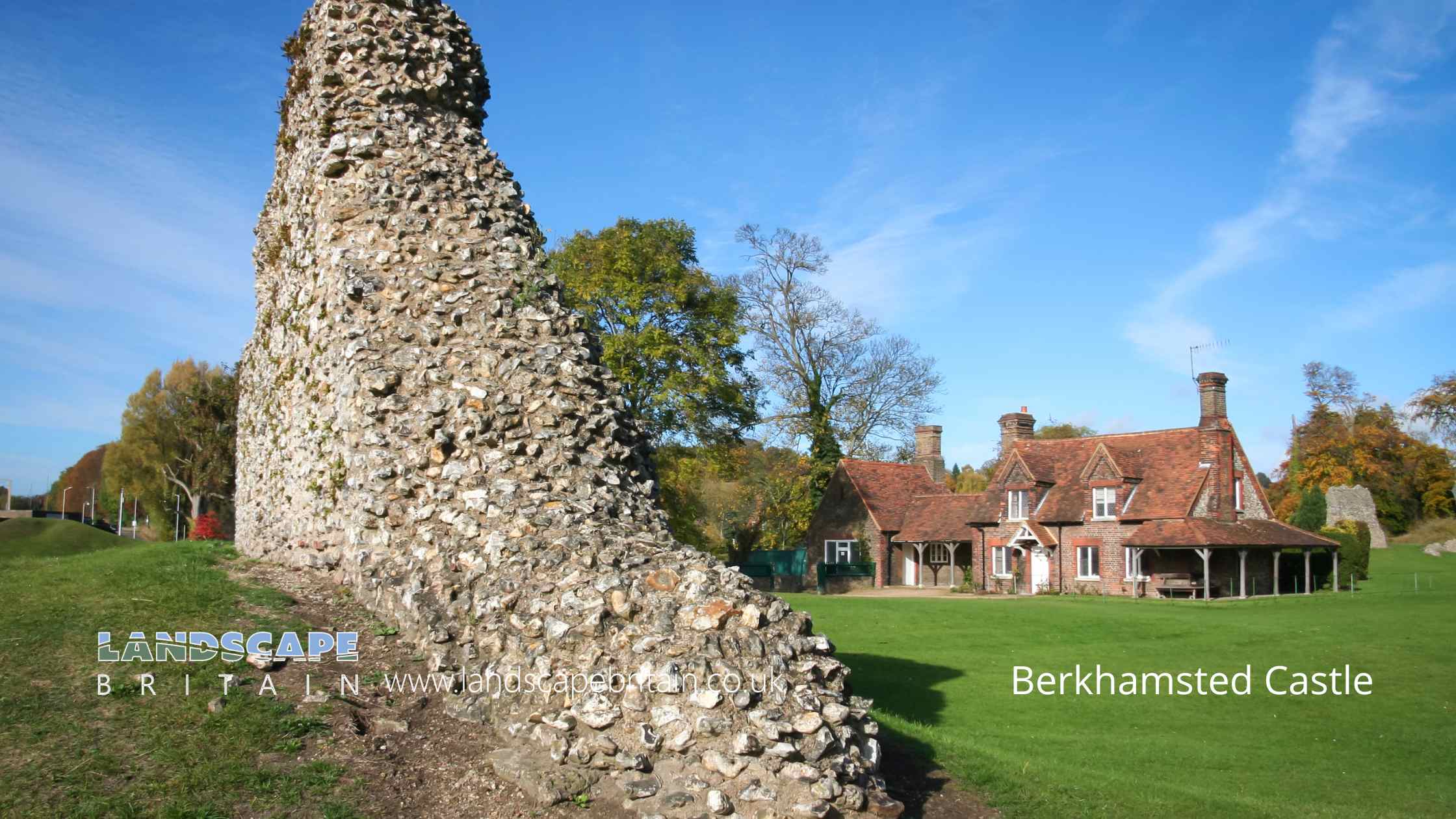
Berkhamsted Castle by simongurney
Berkhamsted Castle
Berkhamsted Castle is a significant Norman motte-and-bailey fortification located just north of the town centre of Berkhamsted, positioned along the historic Akeman Street route through the Chilterns. Its design reflects classic Norman military architecture, with a large motte at the north-east corner of a substantial rectangular bailey. The motte itself stands around 14 metres high and is approximately 55 metres across at the base. At its summit are the remains of a circular shell keep about 18 metres in diameter, which includes a medieval well at its centre.
The bailey spans roughly 1.3 hectares, measuring around 130 metres from north to south and 100 metres east to west. It is enclosed by a flint-built curtain wall, reinforced with semi-circular towers spaced at intervals of approximately 55 metres. At the northern end of the bailey, a wall runs from east to west to create a forecourt in front of the motte. Two wing-walls rise from the north-east corner of the bailey up the side of the motte, joining the base of the keep. At the point where these walls meet the keep are the foundations of a now-lost structure, the purpose of which remains uncertain.
Along the western side of the bailey are the remains of a rectangular building believed to have been a chapel, and it is likely that the main hall and living quarters were also situated on this side. The entire structure is encircled by a broad ditch, with an outer defensive ditch and bank beyond that. These earthworks were altered in later centuries, particularly by the construction of the nearby railway and road to the south.
Unusually, the bank to the north and east of the castle includes eight or possibly nine earthen bastions—projecting mounds likely built as siege platforms, indicating the site’s military importance. The original entrance to the castle was through a southern gateway into the bailey, which would once have been accessed by a wooden bridge spanning the ditch.
Berkhamsted Castle is believed to have been founded by Robert of Mortain, half-brother to William the Conqueror, shortly after the Norman conquest. Between 1155 and 1165, it was held by Thomas Becket, then Chancellor of England, during which time major building works were carried out. King Henry II is known to have spent Christmas there in 1163. The castle also saw military action in December 1216, when it withstood a siege lasting two weeks by the forces of Prince Louis of France.
In the mid-13th century, Richard, Earl of Cornwall, constructed a three-storey tower on the site. The castle later passed to Edward the Black Prince in 1337, and in 1360 it was refurbished to accommodate King John II of France, who had been captured during the Hundred Years’ War. By 1495, the castle had fallen out of use and was left unoccupied.
Archaeological excavations in 1962 and 1967 focused on the south-east section of the curtain wall near one of the half-round towers. Artefacts uncovered included a 13th-century iron arrowhead and pottery, a 14th-century floor tile, and a 17th-century horseshoe, shedding light on the castle’s long period of use.
Today, Berkhamsted Castle is managed by English Heritage on behalf of the Secretary of State for National Heritage. Although the site is now a ruin, it remains an important historical monument and is freely accessible to the public. The visible remains—motte, bailey, stone walls, and earthworks—make it one of the best-preserved examples of its type in England.
Created: 4 May 2025 Edited: 4 May 2025
Berkhamsted Castle Information
Berkhamsted Castle Address
White Hill, Berkhamsted HP4 1LJ, UK
HP4 1LJ
Berkhamsted Castle LiDAR Map
Contains public sector information licensed under the Open Government Licence v3.0
Local History around Berkhamsted Castle
There are some historic monuments around including:
Hertfordshire Grim's Ditch: 210m long section immediately north west of Woodcock HillHawridge Court ringworkBerkhamsted motte and bailey castleMoated site at Grove Farm, Ashley GreenIcehouse 320m south west of Ashridge CollegeMarlin Chapel Farm moated siteBowl barrow in Aldbury Nowers wood, 280m south east of Northfield GrangeBell barrow on Moneybury Hill, 500m NNE of the Bridgewater Monument.Roman settlement at the Cow Roast InnBowl barrow in Lowndes Park, known as the `Rolling Pin'Hertfordshire Grim's Ditch: 230m long section in Hamberlins WoodSlight univallate hillfort on Whelpley HillBowl barrow 900m SSW of Nettleden LodgeEarthwork at Wards CoombeBerkhamsted Common Romano-British villa, dyke and templeBowl barrow in Turlhanger's Wood, 320m south east of Northfield GrangeStool BaulkHertfordshire Grim's Ditch: 990m long section between Crawley's Lane and Rossway LaneRoman site on Moneybury HillTwo barrows at Bridgewater MonumentRomano-British settlement and earthworks on Berkhamsted CommonBowl barrow 950m SSW of Nettleden LodgeBoxmoor House Roman villaSite of Roman building, N of Berkhamsted CastleSections of Grims Ditch.




